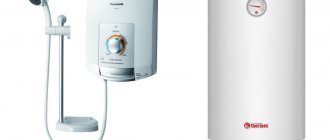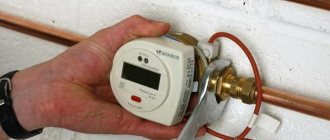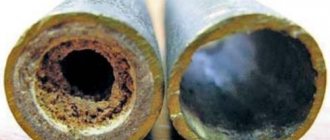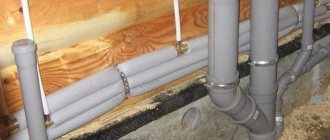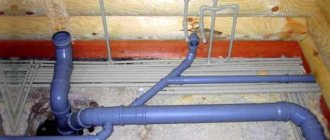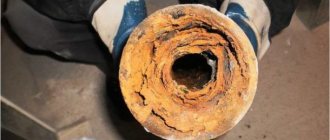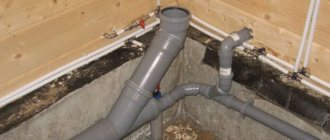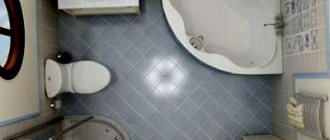Technical progress has not bypassed Russia, but the quality of public services leaves much to be desired. If you want to live comfortably and use hot water every day, the solution is to install a gas water heater in your apartment. Gas equipment cannot be installed without permission - it is unsafe for you and your neighbors. You need to learn how to properly prepare documents and what requirements to comply with when connecting.
It is not recommended to act on your own, as at best you will receive a fine, at worst it will lead to an emergency.
If the column has already been installed before
When changing a water heater in case of malfunction, the device passport must also be replaced. If you install a gas water heater yourself, then the passport of the new device will not contain notes on commissioning and inspections.
According to fire safety requirements, gas equipment in homes must be inspected annually. Unauthorized replacement of a water heater will not go unnoticed and most likely the device will be turned off and sealed
After receiving the comment, it will be necessary to reconnect the column, inviting certified specialists.
Their responsibilities include inspecting the ventilation system. In older homes, they may become clogged with debris. It is dangerous to operate clogged ventilation ducts. This can cause carbon monoxide poisoning, which can be fatal. If the decision to install the water heater yourself is made, then first of all you need to check the ventilation.
Types of water heaters and boilers for apartments
If we talk about gas heaters, they can be flow-through or storage. But in Russia, gas boilers are not widely used, because they are less convenient, cost more and take up a lot of space. They should only be installed if the gas supply is too weak. Mostly they install instantaneous gas heaters.
It’s not easy to install a geyser: you need to comply with safety requirements and you want to fit it beautifully into the interior
Modern models may have a closed or open combustion chamber. Open ones are a little safer and require less paperwork during installation. They are needed if there is no chimney in the house. The latter are suitable if the old heater is being replaced with a new one, the chimney and gas supply have already been made and tested.
Suppliers offer 3 types of power. 17-20 kW is needed for a one-room apartment with 1 inhabitant. If a person takes a shower, there is no longer enough power to wash dishes. Devices with a power of 20-26 kW are indispensable for apartments. They provide 15 liters of water per minute at a temperature of 40 degrees. The power of an average heater is enough for a family of 4 people and an apartment with 1 shower and 2 sinks. A power of 26-28 kW is suitable for two-level apartments or houses.
Requirements for a room with gas equipment
The place where the gas water heater will be installed must have a cubic capacity of more than 7.5 m3. The height in the room should not be lower than 2.0 meters. According to the standards, this height is sufficient for a gas water heater. The room must have glazing.
The window cannot be solid; it must be possible to ventilate in case of leakage. The total glazing area (without frame) is determined by the formula:
C=O*0.03,
Where:
C is the glazing area. O is the volume of air in the room.
The window must allow air to pass through for emergency ventilation. An ordinary kitchen fully meets these requirements if it is equipped with a door. If there is no door in the kitchen, then it must be installed.
Approximate layout of the column, taking into account fire standards. The door must have at least 0.8 m square meters of closed area without glazing
It is advisable to install a gas analyzer in the room. It will help detect gas leaks. This device is optional, but helps monitor the operation of gas appliances. It reacts to excess propane in the air, and then warns about it with a signal.
Image gallery
Photo from
Location of the gas water heater
Standardized minimum ceiling height
Availability of ventilation devices
Ventilation gap in the used room
Features of self-installation
In the case of a simple replacement of the unit, its installation can be carried out without the involvement of specialists, since the communication connections are already available and all that remains is to change the equipment.
When carrying out installation operations, the following points must be taken into account:
- First, you should mark the mounting points for the speaker on the wall, for which you first need to remove its mounting dimensions;
- the hanging location should be chosen in such a way that the distance to the nearest outlet is at least 0.5 meters (with a room height of up to 2.75 meters);
- with a higher room height, this distance may be slightly less (up to 0.25 meters).
For safety reasons, the height of the gas water heater on the wall should not allow small children to reach the control panel
It is very important to accurately measure the distance between the mounting holes, which allows you to hang the speaker on hooks or special brackets without any difficulty. Taking into account all the above factors, installing a speaker comes down to simply hanging it at the desired height
Requirements for ventilation and chimney
To create air circulation in the room, a ventilation hole is necessary. It should not be clogged, air should pass through it calmly. If you neglect this rule, then in the event of a gas leak, the residents of the apartment will receive poisoning with serious consequences.
The risk of household gas detonation will increase significantly if it is not removed naturally, since a leak can occur at night, when a person is not able to detect it.
For the normal functioning of the gas water heater, an additional chimney must be installed. It can be brought into the common house system or directly onto the street. When constructing a chimney, it must be taken into account that it cannot have more than two bends at an angle of 90 degrees.
The total length of the chimney should not exceed three meters. Three options for the location of the chimney pipe are allowed.
Its location is determined by the location of the water heater. Pipes for removing combustion products must be made of non-combustible materials. It is worth giving preference to chimneys with the lowest thermal conductivity (+)
The pipe must have a vertical section at the point of connection to the water heater. The length of the vertical section must be greater than or equal to 50 cm. The length of the horizontal section of the pipe should not exceed two meters.
It is possible to make a chimney from a flexible corrugated pipe, but it is necessary to prevent its sagging, which can block the removal of combustion products.
The diagram describes in detail how you can and cannot install a chimney in an apartment. In addition to the length of the pipes, there are requirements for their slope. For each meter it is necessary to observe a two-degree slope (+)
If the installation of the column does not involve a chimney, then you cannot limit yourself to a ventilation hole in the wall. It is necessary to install a full-fledged hood, but even in this case, the gas service will have questions about such a carbon monoxide removal system.
Image gallery
Photo from
Smoke exhaust from a gas water heater
Corrugated pipe for chimney
Construction of a gas outlet from polymer corrugation
Chimney made of rigid pipes and bends
Tools and materials
During installation you will need the following:
- Impact drill or hammer drill with a drill bit for working on concrete.
- Open-end wrenches, sizes 27/30 and 32/36.
- Gas (pipe) wrench.
- Unipack sealant.
- Sealant for pipe connections - tow, plumbing flax or FUM tape.
In addition to the water heater you will need to purchase:
- A rosette is a decorative detail through which the entry point of a galvanized pipe into a wall chimney is formed.
- An oblique filter (mud filter) for purifying water from large mechanical impurities.
- Optional: water softening system that prevents the column heat exchanger from becoming clogged with scale. For this purpose, you can use a cartridge with ion exchange resin or a hydromagnetic system.
- Pipeline parts (bends and tees), fittings, hoses and shut-off valves - for connecting the column to the water supply. Please note: it is easier to connect hoses (flexible lines), since the connection does not need to be additionally sealed (gaskets are mounted in the threaded ends).
- A gas hose through which the dispenser is connected to the gas distribution network. It must have a sufficient length and a connecting thread that matches the thread on the gas pipe of the column. If the hose tip does not fit the column nozzle, you will need to additionally purchase an adapter.
- A galvanized steel pipe with a wall thickness of 1 mm - used to connect the device to the chimney. The requirements for wall thickness are determined by the high temperature of the exhaust gases - a thin-walled part will quickly burn out. Many models have such a pipe included.
If you had to buy it yourself, pay attention to the cross-sectional dimensions: their values, as well as the required dimensions of the chimney, must be indicated in the column passport; If there are no special instructions, use the dimensions of the smoke outlet pipe as a guide.
The minimum permissible length of this pipe depends on the ceiling height:
- from 2.0 to 2.7 m: 50 cm;
- over 2.7 m: 25 cm.
Gas hoses from a reliable manufacturer are available for retail sale with a certificate - don’t be lazy and ask to see it.
Installation of a chimney in an apartment with wooden walls
In wooden houses, the use of a blue fuel water heater is allowed, but fire safety standards for installing a gas water heater must be observed. The chimney cannot come into contact with wood; non-combustible material must be placed between them.
Basalt or mineral wool can be used as thermal insulation. It is allowed to use heat-resistant polyurethane foam.
This is necessary to prevent fire in the event of strong heating of the chimney. As a rule, old wooden houses do not have chimneys, or they are intended for stove heating. It is prohibited to install gas equipment in unsafe houses.
Image gallery
Photo from
Correct installation on a wooden surface
Violation of speaker installation rules
Protective apron made of ceramic tiles
Features of the use of thermal insulation
Column layout rules
The water heater cannot be located on a load-bearing wall of the building. This is directly prohibited by the requirements for the installation of geysers. In the event of an explosion, this may result in damage to the building or its partial destruction.
To clarify the possibility of installing the device, you need to take information from the cadastral passport of the apartment and the general plan of the house. This information can be clarified by calling specialists.
There are requirements for the space from the column itself to the opposite wall. The distance should not be less than one meter. This is necessary for free access to the device for its maintenance and inspection. It is also forbidden to install gas supply pipes into the walls.
This makes it difficult to inspect communications and find gas leaks in the apartment. If this violation is detected, an order to eliminate it will be issued and information will be provided on how to correctly install the gas water heater and where to contact.
The wall where the speaker is planned to be installed must be prepared accordingly. Combustible materials such as wallpaper and PVC panels must be removed from it.
The column must be located at a distance of more than 10 cm from the wall. It is not allowed to install a gas water heater on a wooden wall without prior preparation. A steel plate must be installed at the installation site, equal to or larger in area than the back wall of the device.
It is not allowed to install a column above a gas stove. These devices must be at least 1 meter apart from each other. Also, you cannot use the hood for a gas stove as a exhaust outlet for combustion products. You cannot use one chimney for the hood and gas water heater. This is expressly prohibited by safety regulations.
Image gallery
Photo from
Distance standards from the sink
Distance between the stove and the gas water heater
Shut-off valves on the gas supply pipe
Mixer location specifics
Brief instructions for installing a geyser
This information should not be considered as a guide to action. Replacing a water dispenser with your own hands, as well as working with any gas appliances, is prohibited not only by law, but also by common sense: such “amateur activity” in an apartment building can lead to disastrous consequences.
For work use:
- certified geyser;
- PVC water pipe;
- American type fittings;
- pipe cutters;
- soldering iron;
- metal-plastic pipe for gas supply;
- fittings for metal-plastic;
- gas taps;
- salt and magnetic filter;
- Mayevsky crane;
- regular water tap;
- proportional wrenches;
- drill;
- as well as dowels and screws.
Progress of work and basic requirements for them:
The choice of installation location for the dispenser should be based on the possibility of arranging the hood in accordance with all rules and regulations, the convenience of the dispenser location, as well as the possibility of supplying communications.
The volume of the room in which the column will be installed must be 8 m³ or more.
Speakers are installed only on fireproof walls. In another case, the fire-resistant surface is lined with a galvanized sheet from 0.8 to 1 mm thick, having previously secured a sheet of basalt heat-insulating cardboard from 3 to 5 mm thick to the wall.
IMPORTANT! Installing speakers on wooden walls is prohibited!
The column is hung on the wall, taking into account that the installation height can be arbitrary, but do not contradict the rules for installing the air vent. There should be at least 15 cm from the side panel of the speaker to the wall, and a space of at least 60 cm should be left in front of the front panel of the speaker.
At the installation location of the column, mark the fastening points, then drill them with a drill. The column is secured with self-tapping screws.
The standards for installing the connection between the column and the water supply system provide for the use of metal pipes or flexible hoses with an internal diameter of at least 13 mm. In this case, the length of the hose or pipe must be no more than 2.5 m (similar parameters must be observed when arranging a connection to the gas supply system).
Installation of a gas connection to a column must be carried out only with a shut-off valve installed.
Before installing the chimney, check the draft. Under normal conditions, it should be approximately 1.96-29.40 Pa (depending on the type of room).
The gas exhaust pipe must have at least 110 mm in diameter, while its length cannot exceed 2 m, but cannot be less than 300 mm. The slope of the gas exhaust pipe must be at least 2° upward.
IMPORTANT! It is also prohibited to independently carry out the first release of water through the column. All work related to testing the system, installing a new dispenser or dismantling an old one must be carried out only by qualified representatives of GORGAZ. The installation diagram of the dispenser must be included with the product
The manufacturer's advice on installing this device is also given there.
The speaker installation diagram must be included with the product. The manufacturer's advice on installing this device is also given there.
Only kitchens and non-residential premises intended to accommodate these heating devices are suitable for installing speakers.
However, the installation rules prohibit installing a column in the bathroom, because... this room does not meet the basic requirements (see SNiP 2.04.08-87 GAS SUPPLY).
In previous regulations, the installation of speakers in bathrooms was allowed. But after the change in legislation, we can only talk about moving the speaker from the bathroom to the kitchen or any other non-residential premises, if it is necessary to replace the device with a new one.
Figure 4 — Gas water heater installation diagram
The requirements for installing speakers also make it possible to consider each individual case: for example, in a private house that does not belong to typical buildings, it may be possible to install a speaker in a wide corridor or a room without windows, but having access, however, to a spacious room with a window.
Figure 5 — Checking draft before installing a gas water heater
Specifics of gas supply installation
The pipes in the apartment are the property of its owner, but unauthorized changes to the gas supply system cannot be made. For any changes, you must obtain permission from the gas service, otherwise a fine will be issued.
If the gas water heater has already been installed in this place, then this will not cause significant changes to the project. It is enough to turn off the gas valve on the pipe and replace it. If you are installing a water heater for the first time, you will need to do some wiring.
The diagram shows how to properly route gas and water pipes. Depending on the material of the pipes, you will need tools for welding metal or soldering plastic (+)
When installing pipes yourself, you must follow the following rules:
- Turn off the gas before starting work.
- Carry out work with an open window.
- Remove debris from pipes that may have arisen during installation.
- Do not route pipes through door and window openings.
- Do not use the ventilation shaft for laying pipes.
- Do not install the gas pipeline into the wall.
- Do not use flexible hoses longer than 3 meters.
- Paint metal pipes.
Particular attention should be paid to sealing the connecting elements of the gas pipeline. To do this you need to use a sealant and sealant. After completing the wiring, you can begin installing the device.
Documents for installing a geyser
IMPORTANT! It is the chimney, not the ventilation system!
- technical passport of the purchased dispenser: in the case when you have decided on the choice of device, but have not yet purchased it, it is enough to indicate the model of the dispenser (the data will be needed when drawing up a project at GORGAZ);
- a drawn up installation project with a clear indication of technical specifications for changing the installation location of the column (execution of the project is also ordered from GORGAZ);
- an application for its reconstruction drawn up and signed by the owner of the apartment (submitted to the city administration);
IMPORTANT! When submitting such an application, you will need to have in your hands a ready-made reconstruction project, documents for this apartment and documents confirming your ownership of these square meters. application for completion of work (submitted to GORGAZ, having an approved project in hand)
application for completion of work (submitted to GORGAZ, having an approved project in hand).
After approval of the plan for all work, gas workers, if you still managed to obtain permission to install the pump in a new location, will have to:
- make an insert into the gas supply pipe;
- install a gas meter;
- hang a column;
- paint the gas pipe yellow (the accepted standard for marking gas pipes);
- line the wall behind the column with non-combustible materials.
In addition, a separate water supply must be installed.
When the work is completed, you will be required to call a specialist from the regional gas service. He will set up and launch the column. After this, the gas meter is sealed.
And that is not all. Upon installation of the dispenser, you will also need to obtain a certificate from the fire department, a certificate from technical supervision, and a certificate of acceptance of the dispenser into operation. And the new project must be included in the BTI.
Figure 2 - Functional diagram of a gas water heater
When choosing a column, focus on:
- speakers Viessmann, Buderus, Bosh, Wolf and Vaillant;
- circulation pumps for hot water supply systems from Grundfos or Wilo;
- water treatment equipment from Grunbeck;
- metal-plastic pipes, fittings for them, air vents and safety groups from the German company Oventrop.
Checking the tightness of gas channels
After installing the water heater, you need to check the gas pipes for leaks. If you have a gas analyzer, this greatly simplifies the procedure and improves the quality of the test. If this device is missing, then you can use the old method.
To do this you will need regular soap, a jar and a brush. The soap is dissolved in the jar to form a liquid emulsion. Next, using a brush, the emulsion is applied sequentially to the pipe joints. As you apply, you need to monitor the appearance of bubbles in the treated areas. If they appear, the leak must be eliminated.
Before testing for leaks, you must take the necessary safety precautions. Be sure to turn off all electrical appliances
Under no circumstances should you check for gas leaks using fire. This is dangerous and may cause an explosion. There is no point in risking your life and the lives of your neighbors.
Gas equipment requires regular inspection and periodic cleaning. You can clean the dispenser yourself, but if you have no experience at all in servicing such systems, it is better to contact a company that has entered into an agreement with you for the supply of gaseous fuel and maintenance of the devices involved.
Guidelines for choosing a unit
1. Which appliance is best for you: electric or gas.
2. Having calculated how much hot water you need, select the volume of the storage water heater or the power of the instantaneous water heater.
3. Decide on the installation location of the water heating device: on the wall, above the sink or under it and select the desired model.
2016-12-30
Sergey Dyachenko
To figure out which is better – a boiler or a gas water heater, let’s look at the pros and cons of both devices.
Advantages of the boiler:
- Easy to install. To install a storage water heater, you do not need to collect any documents or permits. There is no need for good ventilation and a chimney.
- Possibility to provide warm water to several water points at once.
- Independence from water supply pressure. Where the gas water heater does not turn on due to low pressure, the boiler will work properly.
- Silence. A tubular electric heater is used for heating, which does not make any sounds.
Boiler in the bathroom
Disadvantages of storage water heaters:
- Long reheat time compared to columns. If the hot water in the tank runs out, you will have to wait 30 minutes for the next portion to heat up (the reasons why hot water does not flow are described).
- Limited amount of water. If you select the volume incorrectly, there may not be enough water to meet the FGP needs of all residents.
- Dependence on electricity. If you turn off the lights in the room, the water will gradually cool down.
- Large dimensions. This can be a problem in small apartments with small bathrooms, where every square meter is important.
Indirect water heater
Scale accumulation. From time to time the boiler requires cleaning to remove salt deposits. If you do not carry out regular preventive maintenance, then over time the water takes longer to heat up.
In turn, geysers have the following advantages:
- Instant heating. When you open the tap, literally within a few seconds the consumer receives hot water.
- Unlimited amount of water. If there is water in the apartment, the water heater can work constantly. The amount of water is not limited by the size of the tank.
- Small dimensions. New models are compact and do not take up much space in the kitchen.
- Independence from electricity. If the lights are turned off in the house, the speaker will continue to work.
Negative aspects of gas water heaters:
- The need to collect additional documents during installation. Before installing a gas water heater, you must coordinate the project with utility services and obtain permission.
- The need for a quality chimney.
For a gas water heater to operate, combustion products need to be vented outside. To do this, you need a chimney, the condition of which will have to be monitored all the time. If it clogs, then at best the protection will work and the flame will go out. If for some reason it does not work, there is a danger of carbon monoxide poisoning. - Dependence on pressure.
If the water supply system has low pressure, the gas will not open and the water dispenser will not work. Modern models with the ability to adjust the pressure inside the device partially solve this problem. Also, if two water points are connected and you turn on the water at the second, the temperature at the first will drop. This is not very convenient when the water temperature changes while taking a shower.
Impossibility of placement in the bathroom. Due to safety standards, gas instantaneous heaters are prohibited from being installed in bathrooms.
To decide what to choose, it is important to consider the installation location. If you live in a private house that is heated by a boiler, it is advisable to purchase an indirect heating boiler, which will be most profitable
Part of the heat that goes into heating will be used to heat tap water. It is advisable to purchase a combined model that has an additional heating element to provide hot water supply in the summer.
In an apartment where there is no gas meter and 1-2 people are registered, you need to install a gas water heater, which will be cheaper than a boiler due to the fixed payment for gas. An additional argument will be the small size of the apartment; for a Khrushchev-era apartment, a compact gas flow-through heater is better suited.
If you have a night tariff for electricity, purchase a boiler with a large tank volume, because it will be most economical to turn it on at night and then use heated water during the day. Thermal insulation is installed between the body and the tank, due to which cooling occurs very slowly.
Analysis of the most common installation errors
The most common mistake is installing a geyser in the bathroom. As a rule, this room does not have a window. It is especially dangerous to install speakers without a chimney. There are models of water heaters in which carbon monoxide exits through openings, and is removed from the room through a ventilation hole in the wall.
The second most common mistake is the desire to hide the device so that it does not visually stand out from the interior. Often a geyser is installed in a cabinet. This leads to disruption of the proper functioning of the gas water heater.
Even if a distance of 10 cm is maintained from the cabinet walls and there is no bottom bottom, the air flow will still be insufficient to cool the device. It will take longer to cool down, which will significantly shorten its service life.
The third mistake that often occurs is a mixed-up connection of the gas pipe in the column. This leads to water entering the gas pipeline. The liquid gets there through the gas column and then moves down through the pipes. This is how water enters the gas equipment of the neighbors below, completely disabling it.
Liquid removal is carried out by gas services. Once a source is discovered in the owner’s apartment, the gas will be turned off and a fine will be issued. This is what a gas shutoff order looks like
It is impossible to prevent GorGaz workers from performing a shutdown. In case of refusal, the police will be called, as people's lives are at risk.
Installation algorithm
Installation of a geyser must be carried out by specialists
Documentation is regulated by the law on gas supply to the population. The list differs depending on whether you are changing only the model, device and location, or if you are installing the equipment for the first time.
The model is changing
The column becomes outdated over time and can be modernized by replacing it with a more modern one
- Buy a certified gas heater. which is allowed to be installed.
- Take from the housing office certified copies of the gas and water supply system diagrams with the equipment installation location clearly marked.
- Then submit an application for replacement, subject to maintaining the installation location, to the gas service. there are also applications for the repair of water and gas mains on the site.
- The gas service will do the work, and it will issue a certificate of commissioning of equipment and compliance with the requirements.
Changing the device and installation location
How to install a gas water heater video master class:
- You will need to change the gas supply, water supply, and air venting.
- Come to the fire department to pick up a chimney condition report.
- Order a transfer project from GORGAZ or a private certified organization and receive it.
- An apartment building will require permission for redevelopment from the city administration.
- You must have in your hands an act, a project, a permit, a technical passport of the boiler or water heater, a document on the ownership of the apartment. With these documents and the application, contact the gas service again.
- Specialists will install and connect the equipment and conduct the first start-up. Then they will seal the meter and issue a Certificate of Commissioning.
- At the end, you should have in your hands certificates that confirm safety from the fire inspection, technical supervision, and commissioning. Information about the transfer is additionally submitted to the BTI.
First installation
To install a geyser you need to collect quite a lot of documents
If gas is not supplied to the house, you will need to build a gas supply line. This is an expensive process, and many owners of private houses prefer to make do with solid fuel boilers. For multi-apartment buildings, gas supply is carried out by the developer, the housing office, or contributed by the owners together.
In a small kitchen, placing a speaker is a little problematic, since every centimeter counts
- Obtaining documentation includes consent to supply gas from distributors and transporters, calculation of consumption, obtaining technical conditions, permission for land allocation for the gas pipeline.
- Design consists of concluding a project agreement, collecting and examining documentation, and approval by the authorities listed in the previous paragraph.
- Construction consists of construction and installation work and commissioning.
- At the end, a gas supply agreement is concluded with GORGAZ or OBLGAZ.
Have you already chosen an espresso coffee maker for your home?
Read how to fix a leaking faucet here.
Responsibility for unauthorized installation
If the insertion into the pipe for connecting the column is made bypassing the metering device, then such an act falls under Art. 7.19 AC RF. For this, administrative liability is provided in the form of penalties.
For individuals, fines range from one and a half to two thousand rubles. This is the least possible measure for those illegally connected to the gas system. How an official connection to a centralized gas main is made is described in detail in the following article, which we recommend that you read.
In addition to the administrative code, unauthorized tapping and installation of gas equipment is subject to Federal Law No. 69 “On Fire Safety.” According to the text of the document, the owner of the property bears administrative or criminal liability depending on the severity of the consequences.
If the actions cause property damage to third parties, the owner will be obliged to compensate it in full. In addition, a fine of RUR 80,000 may be imposed for a violation. If significant harm was caused to the health of neighbors, the owner may be taken into custody and imprisoned for up to two years.


